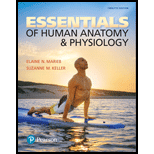
More than one choice may apply.
Pulmonary veins deliver freshly oxygenated blood from the lungs to the
right ventricle.
left ventricle.
right atrium.
left atrium.
Introduction:
Human heart is divided into four chambers, two atria on the left and two ventricles on the right. The upper chambers, atria, receive blood that returns back to the heart. The lower chambers, ventricles, receive blood from the atria, which pump blood out in the arteries.
Answer to Problem 1MC
Correct answer:
The pulmonary veins carry freshly oxygenated blood from the lungs to the left atrium before leaving the heart into the aorta, which in turn helps in the circulation of the blood throughout the body.
Explanation of Solution
Explanation for the correct answer:
Option (d) is given as left atrium. The deoxygenated blood from the right ventricle move to the pulmonary artery and releases carbon dioxide in the lungs. This fresh oxygen-rich blood is returned back to the left atrium of the heart through the pulmonary veins, which later flows into the left ventricle. Hence, option (d) is correct.
Explanation for incorrect answers:
Option (a) is given as right ventricle. The deoxygenated blood rich in carbon dioxide flows into right atrium by systemic circulation and is pumped into the right ventricle. This blood is later pumped out from right ventricle by pulmonary artery, which delivers it into the lungs. The pulmonary arteries carry deoxygenated blood from the heart to the lungs. So, it is an incorrect option.
Option (b) is given as left ventricle. The left ventricle consists of oxygenated blood received from the left atrium. The aorta supplies this blood to the entire body. So, it is an incorrect option.
Option (c) is given as right atrium. The right atrium receives deoxygenated blood that returns from all the organs except the lungs. So, it is an incorrect option.
Hence, options (a), (b), and (c) are incorrect.
Thus, it is evident from the above explanation that pulmonary veins carry freshly oxygenated blood from the lungs to the left atrium.
Want to see more full solutions like this?
Chapter 11 Solutions
Essentials of Human Anatomy & Physiology (12th Edition)
- Identify the indicated structure (Saprolegnia). a. antheridium O b. oospore c.sperm d. auxospore e. tetraspore Of. zygosporearrow_forwardUsing information from the primary literature (several references have been provided as a starting point below) please answer the following question: Based on your review of the literature on rewilding, what are the major scientific pros and cons for rewilding? Please note that the focus of this assignment are the (biological) scientific issues associated with rewilding. As will be discussed in class, there are a number of non-scientific issues involved or implicated in rewilding, all ultimately affecting the public acceptability of rewilding. Although these issues are important – indeed, critical – in this assignment you should focus on the biological science issues and questions. Details: You must enumerate at least two pros and at least two cons. Your answer should be no more than 500 well-chosen words, excluding references. Think carefully about how best to organize and structure your answer. Aim for high information density: say a lot, but say it succinctly. Recall Nietzche’s…arrow_forwardUsing information from the primary literature (several references have been provided as a starting point below) please answer the following question: Based on your review of the literature on rewilding, what are the major scientific pros and cons for rewilding? Please note that the focus of this assignment are the (biological) scientific issues associated with rewilding. As will be discussed in class, there are a number of non-scientific issues involved or implicated in rewilding, all ultimately affecting the public acceptability of rewilding. Although these issues are important – indeed, critical – in this assignment you should focus on the biological science issues and questions. Details: You must enumerate at least two pros and at least two cons. Your answer should be no more than 500 well-chosen words, excluding references. Think carefully about how best to organize and structure your answer. Aim for high information density: say a lot, but say it succinctly. Recall Nietzche’s…arrow_forward
- Now draw a rough sketch of what the control data might look like if in addition to the specific binding, there was also a considerable amount of nonspecific binding (again using a normal dose/response curve) (do % total bound ligand vs concentration)arrow_forwardWhat are functions of cuboidal cells in the kidney? Select all that apply. Concentration of gases Dilution of chemicals Secretion of molecules Nutrition to tissues Support of tissues Absorption of moleculesarrow_forwardquestion1 In plants, epithelial tissue is only found as the outermost cell layer and acts as a barrier. In humans, epithelial tissue is found inside the body as well as on the surface. What function(s) does/do epithelial tissue carry out in humans? Select all that apply. Waste storage Filtration Oxygen transport Protection Diffusion Osmosis Absorptionarrow_forward
- What words best describes this organism? a. Unicellular/nonmotile Ob. unicellular/motile c. colonial/nonmotile d. colonial/motile e. multicelluar O f. siphonous g. none of thesearrow_forwardIdentify the phylum or class. a. Euglenophyta b. Dinoflagellata c. Bacillariophyceae d. Oomycetes e. Phaeophyceae O f. Myxomycota g. Xanthophyceae ○ h. Chrysophyceae i. Dictyosteliomycota O j. Rhodophyta Ok. Chlorophyceaens I. Charophyceaensarrow_forwardWhat is produced inside the indicated structure (Fucus). a. eggs O b. antheridia ○ c. sperm d. zygotes e. none of thesearrow_forward
 Human Physiology: From Cells to Systems (MindTap ...BiologyISBN:9781285866932Author:Lauralee SherwoodPublisher:Cengage LearningBasic Clinical Lab Competencies for Respiratory C...NursingISBN:9781285244662Author:WhitePublisher:Cengage
Human Physiology: From Cells to Systems (MindTap ...BiologyISBN:9781285866932Author:Lauralee SherwoodPublisher:Cengage LearningBasic Clinical Lab Competencies for Respiratory C...NursingISBN:9781285244662Author:WhitePublisher:Cengage Medical Terminology for Health Professions, Spira...Health & NutritionISBN:9781305634350Author:Ann Ehrlich, Carol L. Schroeder, Laura Ehrlich, Katrina A. SchroederPublisher:Cengage Learning
Medical Terminology for Health Professions, Spira...Health & NutritionISBN:9781305634350Author:Ann Ehrlich, Carol L. Schroeder, Laura Ehrlich, Katrina A. SchroederPublisher:Cengage Learning Biology (MindTap Course List)BiologyISBN:9781337392938Author:Eldra Solomon, Charles Martin, Diana W. Martin, Linda R. BergPublisher:Cengage Learning
Biology (MindTap Course List)BiologyISBN:9781337392938Author:Eldra Solomon, Charles Martin, Diana W. Martin, Linda R. BergPublisher:Cengage Learning





